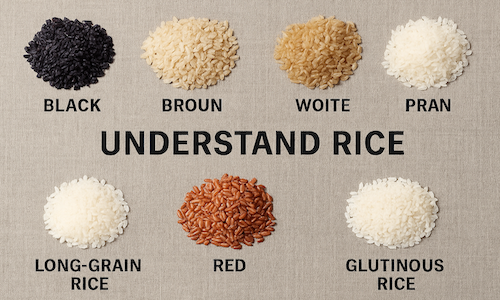Rice is one of the most widely consumed grains in the world, forming the backbone of countless cuisines from Asia to the Americas. While most people are familiar with common white rice, there are actually dozens of varieties, each with distinct flavors, textures, nutritional profiles, and best uses in cooking.
In this guide, we’ll break down rice types by grain length, color, cultivation method, and nutritional benefits, so you can better choose the right variety for your kitchen or restaurant.

Rice by Grain Length
Short-Grain Rice
Short-grain rice has a rounder, plumper shape (less than 6.2 mm in length) and tends to be sticky once cooked. This stickiness makes it ideal for dishes where rice needs to hold together, such as sushi, rice pudding, or Japanese onigiri.
-
Koshihikari – A premium Japanese short-grain rice also grown in Australia, prized for its slightly sweet flavor and perfect stickiness.
-
Best use: Sushi, porridge, rice pudding.
Medium-Grain Rice
Medium-grain rice falls between short and long grains, with a length-to-width ratio of about 2–3. It is moist and tender, but not as sticky as short-grain rice.
-
Calrose Rice – A California variety often seen in supermarkets, widely used in Asian and fusion cuisines.
-
Arborio Rice – An Italian medium-grain variety used for creamy risotto thanks to its high starch content.
-
Best use: Paella, risotto, soups, everyday meals.
Long-Grain Rice
Long-grain rice is slim and elongated, with a length-to-width ratio greater than 3. When cooked, the grains remain fluffy and separate, offering a light texture.
-
Basmati Rice – Famous for its nutty aroma and fluffy texture, often paired with Indian curries.
-
Jasmine Rice – A fragrant Thai long-grain rice, perfect for Southeast Asian stir-fries and coconut curries.
-
Best use: Fried rice, biryani, pilaf, curry sides.

Rice by Color
White Rice
The most common type, white rice has its husk, bran, and germ removed during milling, leaving behind mostly carbohydrates. It’s soft, easy to digest, and suitable for all ages, though it has fewer nutrients compared to whole-grain varieties.
-
Nutrition: High in carbs, quick source of energy.
-
Best for: General cooking, elderly and children due to easy digestion.
Brown Rice
Brown rice is simply white rice with the bran and germ intact. This makes it chewier and more nutritious, with extra fiber, vitamins, and minerals. Its low glycemic index helps stabilize blood sugar.
-
Benefits: Improves digestion, prevents colon diseases, stabilizes blood sugar.
-
Best for: Health-conscious diets, diabetic-friendly meals.
Black Rice
Also called “forbidden rice” or “black pearl,” this variety is rich in antioxidants and anthocyanins, giving it a deep black-purple hue.
-
Benefits: Nourishes kidneys, improves circulation, supports digestion, and boosts immunity.
-
Best for: Rice bowls, congee, desserts.
Purple Rice
Purple rice has a natural sweet aroma and a chewy texture. Like black rice, it is nutrient-dense and packed with antioxidants.
-
Benefits: Supports blood circulation, strengthens the spleen and stomach, relieves cough.
-
Best for: Congee, desserts, traditional herbal diets.
Yellow Rice
Known as millet rice in some regions, yellow rice is slightly larger than millet and becomes sticky when cooked. Depending on the variety, it can be glutinous or non-glutinous.
-
Benefits: Helps nourish the lungs and intestines, aids digestion.
-
Best for: Brewing rice wine, porridge, steamed rice.
Red Rice
Red rice is an heirloom variety with a reddish husk, closer to wild rice in form. It is loaded with anthocyanins and dietary fiber.
-
Benefits: Lowers blood pressure, reduces cholesterol, improves anemia, delays aging.
-
Best for: Healthy bowls, salads, whole-grain side dishes.
Wild Rice
Despite the name, wild rice is technically a grass seed rather than true rice. It has a nutty flavor and chewy texture, with very high fiber and protein.
-
Benefits: Supports digestion, improves mineral intake, helps prevent anemia.
-
Best for: Grain blends, vegetarian meals, stuffing.

Rice by Cultivation
Organic Rice
Organically grown rice is cultivated without synthetic fertilizers or pesticides. This natural farming method preserves more nutrients and ensures food safety.
-
Benefits: No pesticide residues, richer flavor, safer for long-term consumption.
-
Best for: Health-conscious consumers, eco-friendly dining.
Selenium-Enriched Rice
This functional variety is cultivated in selenium-rich soil or supplemented with selenium during growth. Selenium is an essential trace element with powerful antioxidant effects.
-
Benefits: Anti-aging, immune boosting, detoxification, blood sugar regulation.
-
Best for: Functional diets, health food markets.

Nutritional Highlights of Different Rice Types
-
White Rice: Easily digestible but lower in nutrients.
-
Brown Rice: Rich in fiber and stabilizes blood sugar.
-
Black & Red Rice: High in antioxidants, protect against chronic disease.
-
Wild Rice: High in fiber and minerals, ideal for vegetarians.
Conclusion
From fluffy long-grain basmati to antioxidant-rich black rice, the world of rice is incredibly diverse. Each type brings unique flavors, textures, and health benefits, making rice not just a staple, but a versatile ingredient for cuisines worldwide.
Whether you’re running a restaurant or experimenting in your home kitchen, understanding these differences helps you choose the right rice variety for every dish.

Chefco – Your Partner in Perfect Rice Cooking
At Chefco, we provide everything you need to prepare rice the right way — from commercial rice cookers that guarantee consistent results, to sushi preparation tools designed for sticky short-grain rice. Whether you’re serving fragrant jasmine rice, crafting authentic sushi rolls, or cooking antioxidant-rich black rice, Chefco has the equipment to help you succeed in your kitchen.


